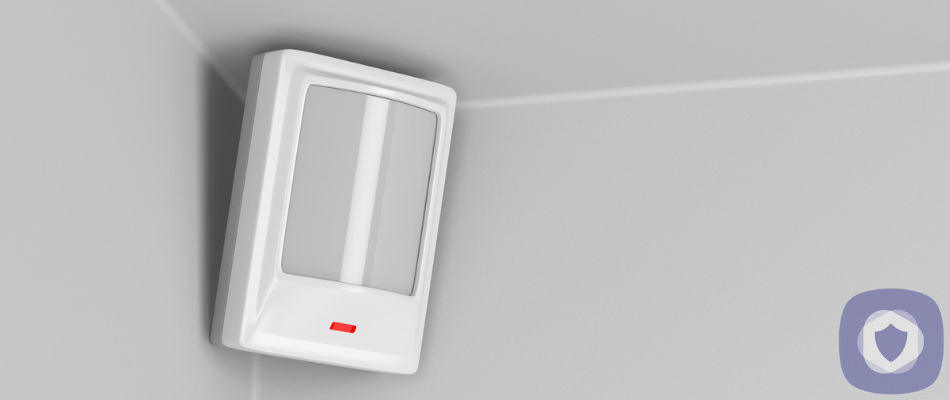A motion detector is a device that uses a sensor to detect people or objects. Sensors can be configured to send an alert to your security systems, and they’re a crucial part of most modern home security systems. Motion sensors could even send alerts to your monitoring team with a monitoring plan, and they may also trigger a burglar alarm.
Motion sensors are usually used to:
- Detect attempts of intrusion on your home or business
- Tell you if people enter areas you’ve restricted. This could be your basement or garage
- Check an area is empty so that they can power down your lights or other electronics
Types of motion sensors
There’s quite a variety of motion sensors available, and you may even find dual-technology motion detectors that combine two different types in one. For example, a PIR can activate a microwave sensor to verify the issue before the system is alerted to a disturbance. We’ll take a look at some of the most common types of motion sensors.
Tomographic motion sensors
Tomographic sensors are most often used for large commercial operations. Tomographic sensors deploy radio waves to identify disturbances in the area. Unlike other sensor types, Tomographic sensors can detect movement and other objects through walls, making them ideal for a larger area.
Passive Infrared Sensors
The PIR motion sensor is a commonly used sensor that you may have seen in office spaces. They are inexpensive, easy to manufacture, and simple to use. Put simply, it senses movement by tracking heat. PIRs have a pyroelectric sensor that senses radiation – which everything produces at least trace amounts of. But living objects make a good amount of body heat, too.
PIR’s have two slots made of a material that is sensitive to infrared energy; a differential change between the two creates a pulse that the sensor interprets as a movement.
Microwave sensors
Similar to a radar speed gun, microwave sensors detect movement by sending out a high radio frequency and measuring the reflection off of an object. If it does sense a frequency shift, the motion detector activates. Microwave sensors are less used now, as they’re more vulnerable to electrical interference. But they can cover a more extensive range than PIR’s.
Area reflective sensors
Area reflective sensors emit infrared rays using an LED; with reflective technology, those rays measure the distance of a person or object, allowing for accurate detection when movement occurs.
Ultrasonic motion detectors
These motion sensors detect the movement of people or objects by analyzing ultrasonic sound waves. Some ”listen” for just sounds, while others send out ultrasonic signals to examine how they’re reflected.
Specialized motion sensors
Specialized motion sensors are motion detectors usually part of an alarm system, serving a specific purpose. These are usually PIR sensors or dual technology sensors, and they’re designed for a specified purpose. Let’s take a look at the different types of motion detectors.
Pet-proof motion sensors
A pet-proof motion sensor reduces the chance of false alarms. Most PIR sensors can ignore pets up to a specific size. A dual technology sensor is even better for this, as two sensors must be triggered.
Video activated motion sensors
Some motion detectors work with video cameras that start recording whenever they detect motion. This is a great way to save storage space as it prevents holding hundreds of hours of useless footage. Your security cameras only pick up on moving objects.
Contact sensors
Contact sensors – such as door/window sensors use a magnet to detect when ”contact” is broken – i.e., a door/window is opened. The sensor triggers an alert to the security system and may even send a notification to your cell phone with some of the more modern systems.
Other ways to use motion sensors
Motion sensors can also be used as part of a smart home ecosystem. They’re not just for home security. You can use motion sensor technology for the following:
- Smart doors: Opening and closing automatic doors
- Motion sensor lights: You can turn off lights when no one is in the room
- Automation: Motion sensors are used in various types of automation, such as parking ticket displays and ATMs
How to choose your motion sensors
Different sensor types are better for different things. You can examine several factors to decide which motion sensor is best for your needs. You should consider factors such as budget, intended use, reliability, and the environment you want to use it in.
A tomographic motion sensor is ideal for vast areas such as a warehouse or factory, while a magnetic sensor is only suited for doorways and windows.
Budget is another thing to consider. Motion sensors such as magnetic and passive motion sensors are much better for low-budget household security. In contrast, tomographic and microwave sensors may be best for commercial environments with a high budget. However, a motion-activated security camera would be futile unless kept in a confined area, and it certainly couldn’t manage a whole warehouse effectively. But for a suburban family home, it would be ideal for saving storage space, time, and money while also keeping an eye on the home.
Accuracy is another factor. A tomographic motion sensor will pay for itself if you’re using it in a high-value commercial operation, as they’re highly advanced and accurate.
Magnetic sensors are much more suited to use for small stores or homes. You should carefully consider your needs before you choose your sensor type.
Understanding exactly how the sensors work and their strengths will help you decide what’s best for you.
How to correctly place a motion sensor
For a DIY home security system, you should place motion sensors carefully and think realistically about their surroundings and how your environment could prevent motion detection.
- You should keep PIR sensors away from heat sources, such as heating vents. It’s a good idea to ensure at least 15ft between your sensor and any heat source
- All sensors should be placed in significant points – such as hallways, foyers, and other areas that you’d need to walk through in the home, regardless of where you’re headed. But, ideally, you’d want to prevent any intruders from entering in the first place. So it’s a good idea to place magnetic contact sensors on doors and windows and ensure that your garage is also covered; a floodlight sensor is a great option to cover your garage
- A motion sensor should be placed at around 6-7ft if possible. If you set it too high or too low, you create blind spots
Check out our best security systems.
Summing up
Motion sensors work in different ways, but they can all be used to complete a security system, whether you’re responsible for a multi-million dollar commercial giant or a mid-sized home.
If you opt for a DIY system, you should carefully consider how you place your motion detectors to enable them to work at their best.
This article has been reviewed and approved by Officer Banta.

Officer Banta is the official SecurityNerd home security and safety expert. A member of the Biloxi Police Department for over 24 years, Officer Banta reviews all articles before lending his stamp of approval. Click here for more information on Officer Banta and the rest of our team.

